|
| > iacl.org > Battery Page
Battery Page
|
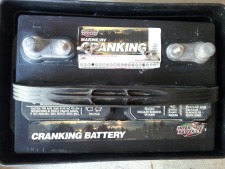 | |
|
A 12 year old cranking battery discharging internally
|
Newest Postings are at the bottom of the page.
We discuss the Automotive, Marine, RV Cranking and Deep Cycle Battery life and failure. Cranking (rated in CCA) is more for cars needing a 30 second massive discharge to turn the starter motor long enough to start the engine. Deep Cycle or Deep discharge, is constructed with thicker material designed to provide a long supply of current for RV or marine application. Both technologies are basically the same.
Battery Failure is attributed to one of the following causes.
1. Column Failure - The battery consisting of 6 cells, one dies catastrophically then the rest, although OK produce about 10.8 volts insufficient to start an otherwise already warmed car.
2. Weak Cell - Place battery on the stress tester and as current is pulled the voltage falls below the nominal 12 V. On the Tester this will appear as going into the yellow area
3. Internal Discharge - An otherwise OK battery discharges in days as opposed to months. It can right away after being charged hold the stress test but over time discharges more quickly than it should.
4. External Discharge - A dirty battery discharges through conductive build-up on it's case. Cleaning the case with detergent and water removes the conductive build up and restores the battery's capacity.
5. Terminal Crud. Batteries live in a "dirty" environment. Oil and chemicals off the road combine with sand and dust to create semi-conductive "grime" that gets on battery studs and connected terminals. Crud prevents good contact to your electrical system. A pocket knife cleans off the post and terminal crud.

Cold Cranking Amps
Not usually seen in sub-automotive style cases, here we have a pair of Yuasa batteries, one rated in CCA (cold cranking amps) and the other without.
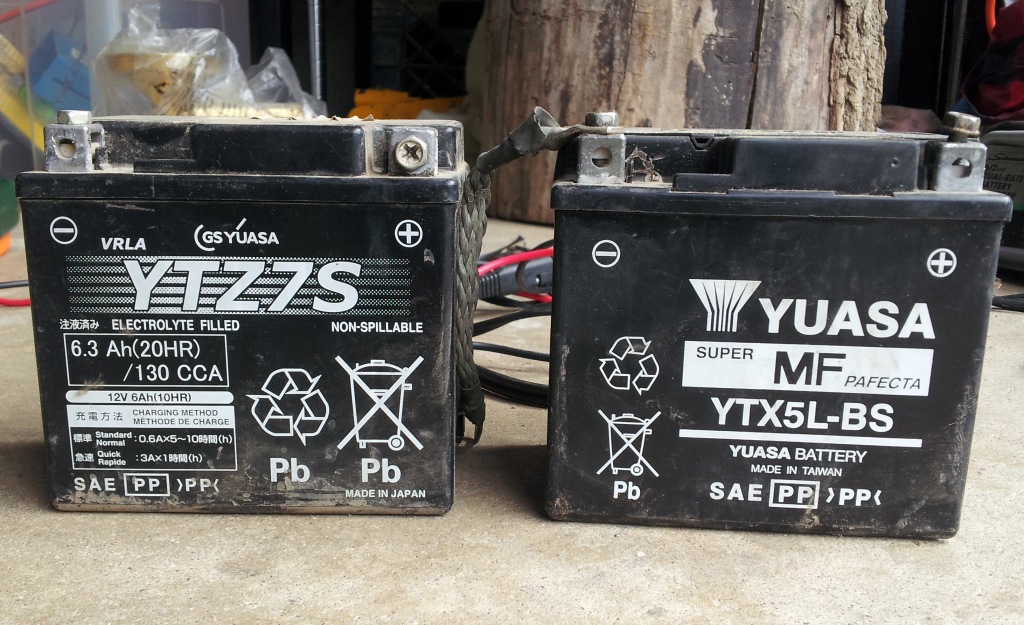
Typically what happens is a company builds and moves into a new better facility and another company takes over at the old facility continuing to turn out product. In this case it looks like Yuasa is either operating both plants or the unmarked battery is older.
Replacement Battery & Useful Tips
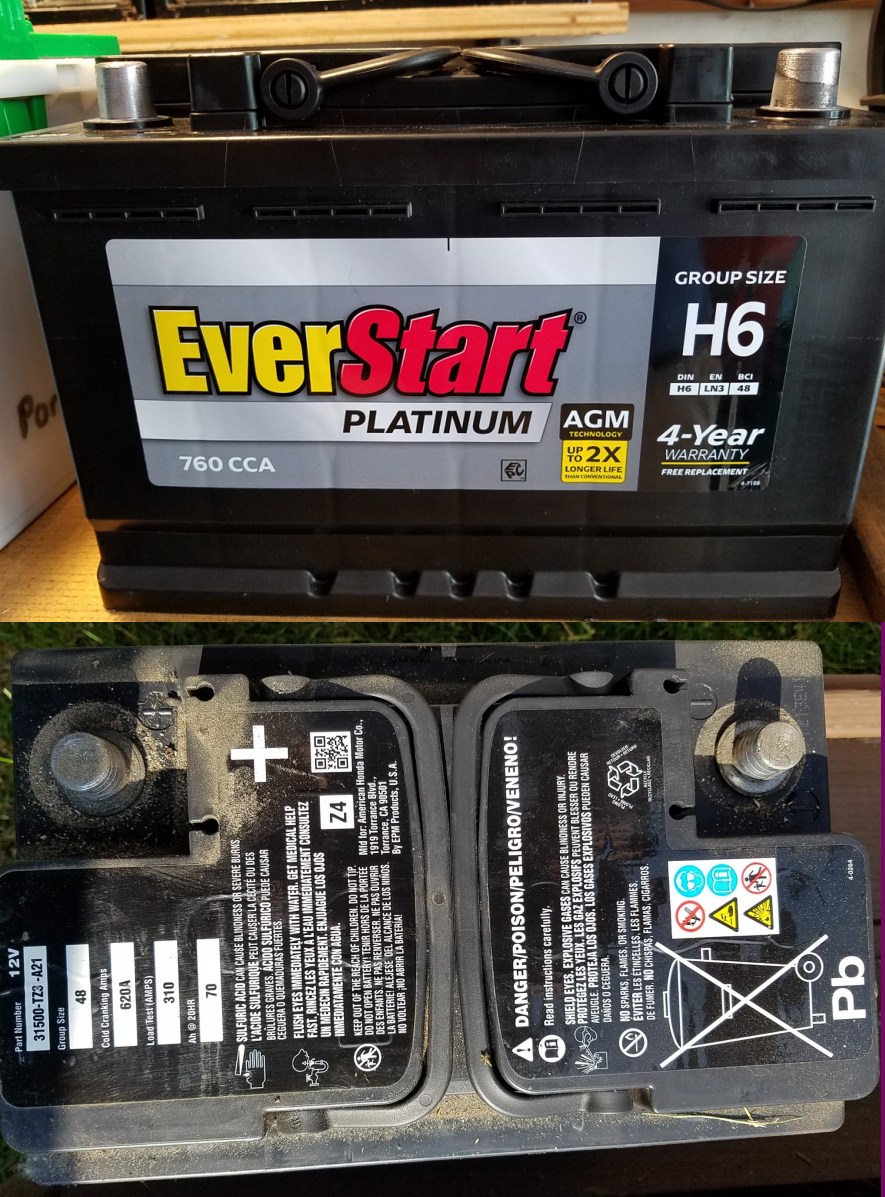
Here we are looking at at the original and replacement battery for a 2018 Honda Minivan. Now Minivans are complex with a lot of electronic systems. The subject of which the source of endless debate regarding electrical problems in said vehicles. My experience on this and late and early model Chrysler Minivans gives rise to the following words:
1. Turn off all radios, fans, lights, A/C systems, etc. before turning off the motor. This one step might solve it all.
2. Replace the original battery. (Honda original was under-powered and under-sized)
3. Replace cabin light bulbs with led equivalents. Useful for active families who like to leave doors open.
4. Re-seat the fuses in your car's fuse box by opening the lid and pressing them back down. (They will back out over time thus riding on increasingly tarnished contacts.)
New Motorcycle Battery Suspecting the 2021 Yuasa not turning over the Intruder's big engine, we find a reasonable priced Lithium Ion replacement. Coming it at about 1/2 the size and less than 1/4 of the original battery's weight, I stacked it up on some spacers and installed in vehicle.
Battery Acid Fire (thank you bravabatteries.com)
Lead-acid battery fires are possible – though not because of the battery acid itself. Overall, the National Fire Protection Association says that lead-acid batteries present a low fire hazard. Furthermore, the NFPA reports that (based on limited information) flooded lead-acid batteries are less prone to thermal runaways than valve-regulated lead-acid batteries (VRLA). That’s because the liquid solution in flooded batteries can inhibit fire better than the materials inside VRLA (Sealed Lead Acid) batteries can.
Frozen Battery Explode
The freezing of battery electrolyte often occurs when the battery is undercharged and exposed to low temperatures. This is because when a battery is fully charged, the water and acid in the electrolyte are combined. And that means it has a very low freezing point. Frozen batteries can “explode” if you apply a charge to them while they’re frozen. But if the battery is not fully charged, the water and sulfuric acid will separate. And this can cause the battery to freeze. If you try to charge or jump-start the battery in a frozen state, it can explode.
Additional reading: https://www.power-sonic.com/blog/sla-thermal-runaway/
05/04/2024 Heavy Tarnish on 5 yr old deep cycle battery Camper battery increasingly difficult to start generator. The battery, though fully charged catastrophically failed (straight to 0 volts) the stress test while in place. Remove battery and re-test and now seems just fine. Discover green tarnish on contact that was preventing current flow. Cleaned up contacts, connectors and re-assembled. Generator started right up. Also installed a knife switch on the return to insure 100% battery disconnect from system while not in use.
05/21/2024 Dead Battery! I left the keys in the ignition position and when I went to go out, the Sequoia battery was clicking. In a rush to to beat the masses to the store I tried to jump off the motorcycle battery using the jumpers and could not get it to crank, then used my the small car battery with the heavy clamps and that started it! Wondering if it would start the camper engine, disconnected positive terminal (it needed cleaning anyway) and was able to start camper engine. Then tried the jumper cable from camper Pos. post to Pos. terminal, it tried but failed to turn over. Suspicions regarding capacity of jumper cords confirmed and eye out for a heavy duty set or just bring along the small car battery.
12/01/2024 Dropped Battery I loaded one of my 4AH Ryobi batteries onto my pole saw and ventured out onto a catwalk over water. In my zeal to cut, failed to attach battery properly and with a "plop" disappears into the drink. My eyes were on the cut so I did not see exactly where it fell in. 10 minutes of raking muck finally it comes up, soaked inside and out. Disassembled, dried and tested. Beyond all hope it seems to be OK. :-)

02/06/2025 E-350 Camper truck terminals Went to start RV engine and got clicking before it started. Rebuilt the suspicious positive post using a clamp with wire cage plate. Got clicking only, battery seemed good so rebuilt negative terminal post which had completely fractured. Engine started OK. Said goodbye to the plastic housings which hid the damage more than anything else.

03/05/2025 Coach Battery Update Despite having rebuilt the post on the positive terminal using a post clamp, calcified material builds up between post and clamp causing voltage and current fluctuations. Rebuild post this time turning it so I can get a wrench on it and using locking washers. Generator starts up. Disengaging negative terminal knife switch in order to negate suspected parasitic draw from the step. (Something in the step is definitely heard to energize for a couple seconds) Also this rat-proofs the camper's DC electrical system.

Rebuilt coach battery posts and clamps
03/13/2025 Coach Post Rebuild take 2 Generator start-up still dodgy on this 45 deg. morning. Current not getting through? Rebuild solenoid connection at generator. No luck. Tried starting off of the jumper battery- weak at best. Decide to remove camper battery completely thinking to replace. Once under sunlight notice the black on the posts. Despite previous cleanings there is tarnish creating "land" thus preventing connectiture. Get out a steel wheel and grind posts to a shine. The positive clamp is likewise interior tarnished and decided to employ a new side post connector clamp from Walmart. Check specific gravity on all columns which read good and the Chicago Electric stress tester displayed better results! Reinstall tight fitting type 27 battery. New hardware, tighten it all down and test prompt generator start up.

Rebuilt coach battery posts polished with a steel wheel and sandpaper touch-up
12/16/2025 Powertrain Rebuild Aftermath Having taken 3 months to complete left me with a 6 month old Die-Hard Silver that was badly depleted. Though I initially suspect the initial charging coming off 11.7V was going OK made the mistake of starting the generator with it only 20 minutes in. Generator starts however upon returning to charging notice an abnormally high rate which would not lessen, big spark and clamps getting warm. Would not charge beyond 12.1 VDC though stress test seemed OK. Sigh, cry and lament for not having pulled it when I visited the coach earlier in the long process. Though in my defense the automatic doorstep does not make this easy. Purchase a case 27 Duralast with similar specs and price from a nearby Autozone and head out camping. Deep cycle batteries are rated in reserve capacity, not Amp Hours or whatever those discount Walmart batteries are speced in.
12/27/2025 Club Car batteries! Club cars run on 6 volt batteries at 36 or 48 VDC. Bought a used one from a guy who did not want to buy a new set which is typically around $1,200. Wondering if there was anything I could do to extend their life. The 36 volt 18 amp charger that it came with did not seem to ever get to the end of it's cycle and had the cells bubbling away. Water looked good. The center banks seemed to be the most robust though none of them where inherently weak on the Chicago electric stress tester. The last bank looked askew so pulled them out and added some framing by way of a piece of angle iron and cleaned them up, bodies and posts. I charged the 3 12 volt "sets" with my 1.5 A charger and all three banks took charge and finish cycle. Along the way I am cleaning components as there is much buildup of grime over everything. We see evidence in parasitic draw as one of the rear lamps (an led replacement) dimly glowing. Also though not having been on any charger for over a day, the cells seem to be "talking" to one another with continued bubbling albeit lessened from when on charge. The system has a 36 volt plus and minus as well as a 12 plus and minus which referenced from the utmost positive post meaning it's return comes in at 24 VDC on the overall stack. Isolate the 3 banks from each other but am reading 24 VDC from the positive post of bank 2 to utmost ground which I was able to clear by removing all system connections.
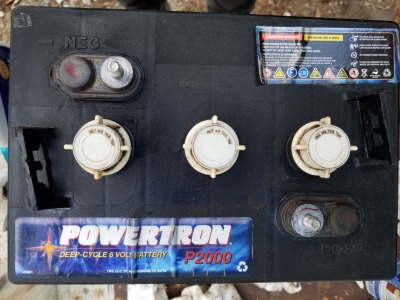
One of the 6 club car batteries cleaned up with terminals polished
Though there is no reference to the batteries current or reserve rating much less a date code we hope continued cleanup and some strategically placed kill switches should end any parasitic draw.
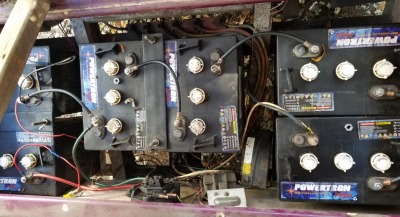
the 6 club car batteries.
|
|
|

